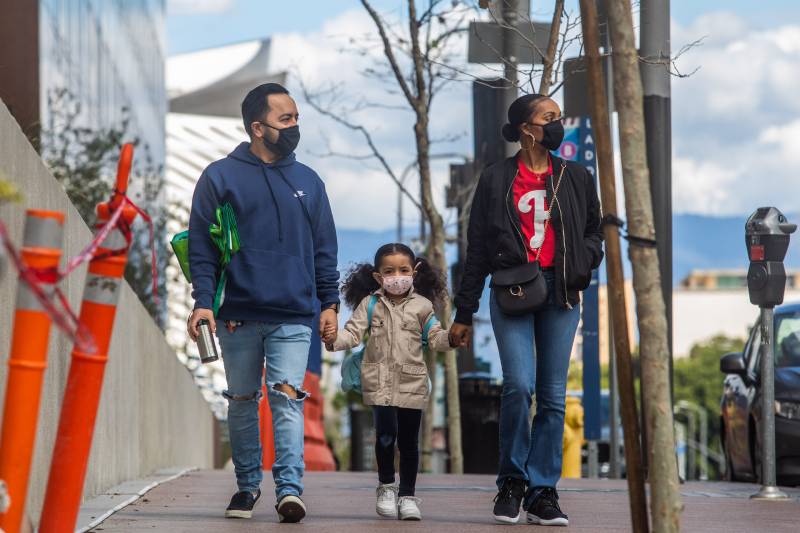Are Kids Contagious?
Doctors say kids do not likely make up a significant cohort of the notorious asymptomatic or presymptomatic coronavirus cases we have heard so much about. Dr. Yvonne Maldonado, an infectious disease expert at Stanford, says outbreaks in China suggest kids are catching the coronavirus at home from adults and not the other way around.
“It’s relatively unusual for kids to transmit the virus to adults,” said Wachter. “That’s different than many other viruses, where the kids are really important vectors. And it’s not 100 percent clear why that is.”
One study suggests COVID-19 may not be gaining a foothold in kids because they lack the host receptor for coronaviruses, which likely burrow into a protein on the surface of our nasal membranes. Researchers at the Icahn School of Medicine at Mount Sinai Hospital in New York City report finding fewer of these structures, which are called ACE2, in the noses of children than are found in those of adults. But a lot more research is needed to confirm this.
At least one case cluster, however, suggests kids can pass the virus on to each other. When a school recently opened in Israel, at least 130 students and staff fell ill. Plus, the low-prevalence data we are seeing in American kids mostly reflects a time when families were staying at home. It’s possible the picture could change dramatically when schools open up.
Scientists are not likely to gain a complete understanding of the virus’ transmission pathways until the widespread availability of antibody testing, which can identify prior infections.
COVID-19 Cases in Children
When kids do catch COVID-19, they experience cold-like symptoms such as fever, runny nose and cough. Vomiting and diarrhea are rare. And children are, so far, not experiencing acute respiratory distress syndrome or septic shock, which is occurring in some adults.
Infants, however, can be quite vulnerable. Research from Italy suggests infants experience severe cases. A study from China looking at 2,143 pediatric patients found that 10% of babies who contracted the virus required hospital care, even if the patients had good overall outcomes.
A few hundred children have developed a new inflammatory syndrome, similar to Kawasaki disease, several weeks after a mild or asymptomatic COVID-19 infection. The illness, Multisystem-Inflammatory Syndrome in Children, or MIS-C, can lead to swelling, high fever, body rash, red eyes and lips, and a strawberry-colored tongue.
Whether COVID-19 is triggering this new disease or it’s a completely separate entity was the subject of a recent UCSF discussion. “It’s not clear yet,” said UCSF pediatric rheumatologist Susan Kim.
Doctors also caution that premature infants and children with underlying chronic health conditions are still at high risk for developing complications.
Is Child Care or Summer Camp Safe?
So what about my dilemma over whether to send my toddler to day care?
“It feels like it’s safe enough to do as long as we’re watching very, very carefully,” Wachter said.
But when the The New York Times asked hundreds of epidemiologists at what point they’d send their kids back to school, camp or child care, just 10 percent said they’d feel comfortable “now.” Twenty percent said they would wait until this summer, and 40 percent said not until fall. All of which is considerably sooner than the majority felt comfortable attending other indoor group events like concerts or movies. Comments from the professionals ranged from “Children are relatively safe” to “Really. Stupid.”
Atkinson-McEvoy recommends parents ask child care providers lots of questions to ensure programs follow state and federal guidelines requiring social distancing and sanitized play structures. California is also limiting child care groups to fewer than 12 kids, and families must enroll in programs for three continuous weeks to ensure lower student turnover. Doctors are optimistic these strategies will reduce transmission.
If possible, ask to tour a facility before signing up. When Atkinson-McEvoy considered sending her daughter to a competitive softball program this summer, she took the leap after she saw the coach was diligently ensuring players stayed far enough apart from each other.
She notes that parents have to weigh potential exposure for the family against the mental well-being of their children.
“We’re definitely starting to see behavioral changes in our children from being at home, including seeing children who are showing signs of anxiety and/or depression,” she said. “Being able to socially connect with peers and resume some normal activity is an important tool one would use to help with that.”
Plus, camps or day care may help tired parents refuel their tanks. If you do take the child-care plunge, you can lower your family’s overall risk by reducing other behaviors like taking fewer trips to the grocery store.

